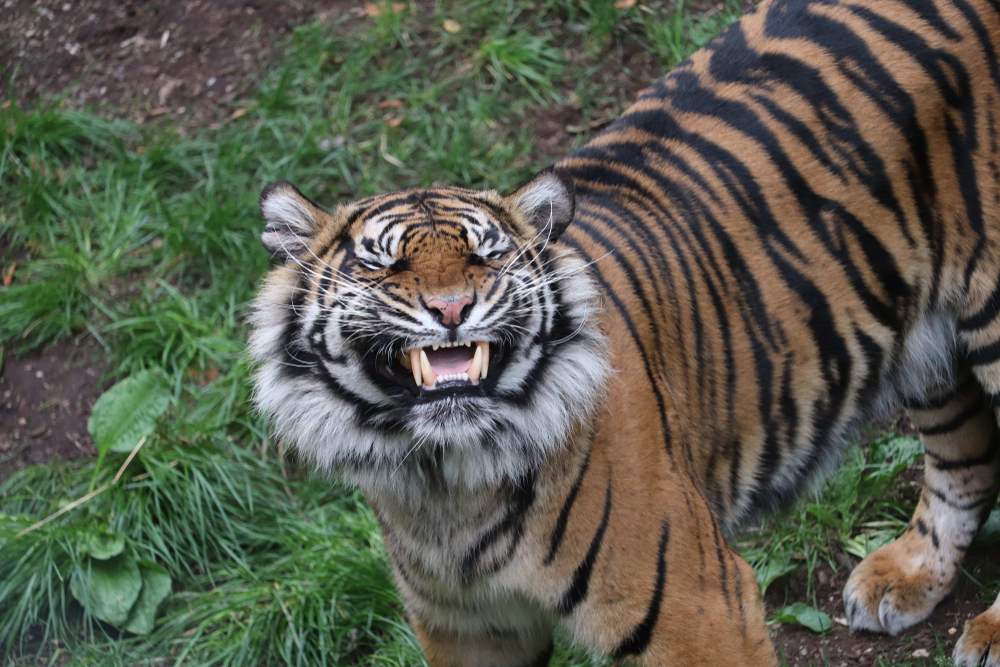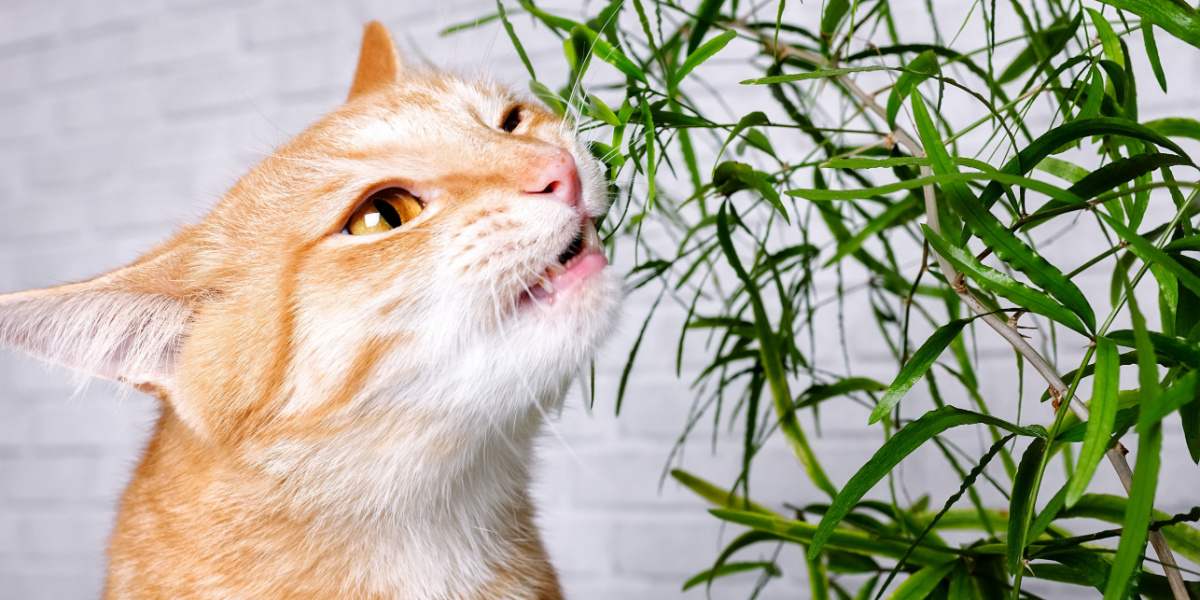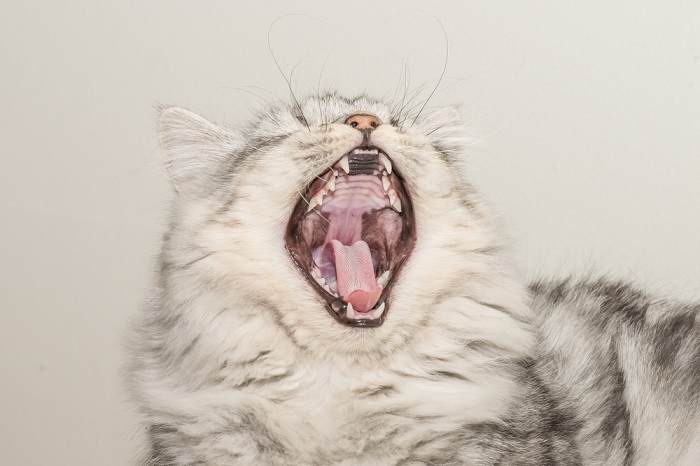
Our beloved cats perform all kinds of bizarre behaviors that are hard for us to understand; one of the most perplexing for many owners is seeing their kitty utilize the flehmen response for the first time.
The flehmen response in cats is used to analyze scents and pheromones by directing them from the mouth to their specialized vomeronasal organ. Cats demonstrating the flehmen response often look like they are sneering or grimacing as they open their mouth and curl their upper lips. Many species exhibit the flehmen response, but it is especially marked in domestic cats.Key Takeaways
Whilst it may look like your cat is pulling a funny face, sneering at something, or grimacing in pain, the actual cause of their odd expression is to direct interesting scents or pheromones to a specialized area above the roof of their mouths called the vomeronasal (or Jacobson’s) organ. In this article, we will delve further into the fascinating world of scent detection and analysis in cats, and describe the flehmen response in more detail.
Also Read: Why Do Cats “Blep”? A Veterinarian Explains
What Does The Flehmen Response In Cats Look Like?

The flehmen response is sometimes referred to as a cat’s ‘stinky face’ due to the grimacing look.
The term ‘flehmen response’ is thought to originate from the German terms flehmen and flemmen, meaning to ‘bare the upper teeth’ and to ‘look spiteful.’ The flehmen response in cats causes them to have a strange expression similar to a grimace or sneer. They tilt their heads up, curl back their upper lips, expose their front teeth, and keep their mouth open for several seconds.
What Other Names Does The Flehmen Response Have?
There are several other terms used for the flehmen response including:
- Flehming
- Flehmen position
- Flehmening
- Flehmen reaction
- Flehmen grimace or sneer
- ‘Stinky face’
Also Read: Cat Anatomy Guide
Do Other Animals Have A Flehmen Response?

Our domestic cats’ larger cousins, such as lions and tigers, also display this behavior.
Cats aren’t the only animals to have a flehmen response; other species which utilize this reaction include:
- Buffalo
- Horse
- Elephant
- Rhinoceros
- Llama
- Goat
- Big cats such as tigers and lions
- Tapir
- Giraffe
- Hedgehog
Also Read: Why Does My Cat Stick Their Tongue Out Sometimes?
What Is The Point Of The Cat Flehmen Response?

The flehmen response encourages scent chemicals up to the roof of the cat’s mouth.
Hopefully, you are now reassured that the funny face you have seen your pet making is not due to a concerning health issue – but why do cats actually use the flehmen response? Cats have an amazing sense of smell which they use to navigate their world, and have more than 200 million scent receptors in their noses (40 times more than us humans!).
As well as their regular scent (olfactory) system, they also have a specialized sensory organ called the vomeronasal organ (or Jacobson’s organ).
The vomeronasal organ is present in snakes, lizards, and many mammals including cats and pigs. It is located in the soft tissue between the hard palate of the mouth and the nasal septum, close to the vomer and nasal bones (hence its name).
The flehmen response encourages scents to move towards the vomeronasal organ via the incisive papilla (a small fleshy structure you can see behind the upper incisor teeth on the roof of the mouth in cats). The incisive papilla is connected to the vomeronasal organ via the nasopalatine ducts (which provide direct communication between the nasal and oral cavities).
Also Read: Why Do Cats Lose Their Teeth?
What Does The Vomeronasal Organ Do?

The vomeronasal organ processes pheromones – chemical messages which help cats communicate.
The vomeronasal organ contributes to the olfactory system by analyzing chemical compounds and sending sensory messages to the brain; cats use it particularly to detect pheromones. Pheromones are compounds that are produced and detected by kitties that elicit particular cat behaviors.
Pheromones are released from several glands located throughout the body, as well as in urine, feces, and saliva. When cats rub against objects (or us!) they deposit pheromones from these scent glands. Areas such as the cheeks, chin, lips, feet, and anal area contain high numbers of these pheromone-producing glands.
Cats use pheromones as a ‘smell’ signal to:
- Identify their territory.
- Identify individual cats, and know if they are ‘friendly’ or not and reinforce bonds.
- Identify sexual partners, and readiness to breed (male cats release a specific facial pheromone which they rub on objects near female cats to increase their chances of obtaining a mate).
- Establish the bond between a mother and her kittens.
- Self-soothe and calm themselves.
- Signal stress or anxiety.
- Orientate themselves within their surroundings.
Also Read: What Are Cat Pheromones And Do They Really Work?
Summary
You would be forgiven for worrying about your pet’s health the first time that you saw your cat display the flehmen response! When they encounter a particularly interesting scent you may see them pull a bizarre facial expression where their lips curl to show their front teeth, and they grimace with an open mouth.
The purpose of this feline sneer (known as the flehmen response) is to draw interesting scents and compounds called pheromones into the mouth and direct them via tiny ducts in the roof of their mouths to a specialized scent analyzer called the vomeronasal organ. The vomeronasal organ is part of the smell (olfactory) system, and by analyzing pheromones it has an important role to play in feline communication such as mother and kitten bonding, courtship, and mating.
Also Read: 7 Common Cat Vocalizations And What They Mean
Frequently Asked Questions
Why Does My Cat Open Their Mouth When They Smell Something?
If a cat encounters a particularly interesting smell or scent it may stimulate the flehmen response in them. As well as causing an amusing facial expression where cats curl their lips, wrinkle their noses, and hold their mouths open; the flehmen response results in maximal delivery of scent chemicals (pheromones) to a specialized olfactory analyzer in the roof of cat's mouths called the vomeronasal organ.
What Triggers the Flehmen Response in Cats?
Any interesting smell can trigger a cat's flehmen response e.g. catnip. However, detecting pheromones - chemical messages - is the most common reason for the response to be triggered in cats. Phermonones are an important form of communication between cats - especially in relation to social bonds, territory, and mating.
Why Does My Cat Raise Their Lip at Me?
It may be that they are exhibiting the flehmen response, which is a smell behavior used to get an in-depth analysis of an interesting smell or scent on you or your clothes. They are most likely to do this if you have been around other cats which have rubbed pheromones from scent glands on their bodies onto you.








When my horse has a flehmen response it usually means she is in pain. A year ago she colliced and I knew due to the Flehmen reaction.